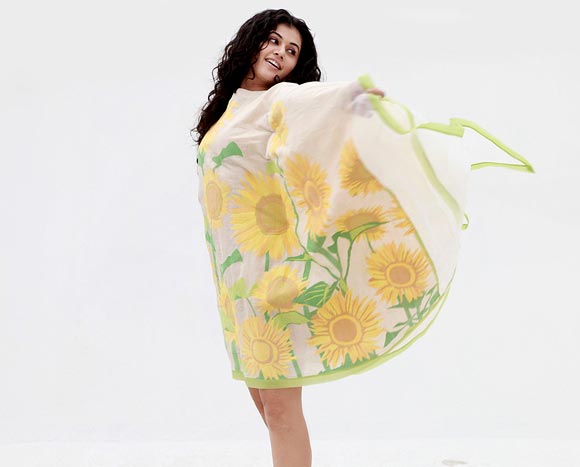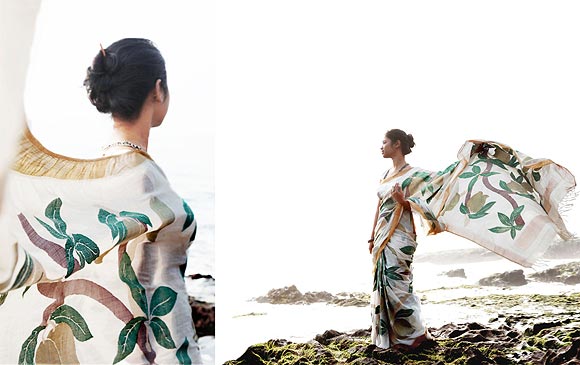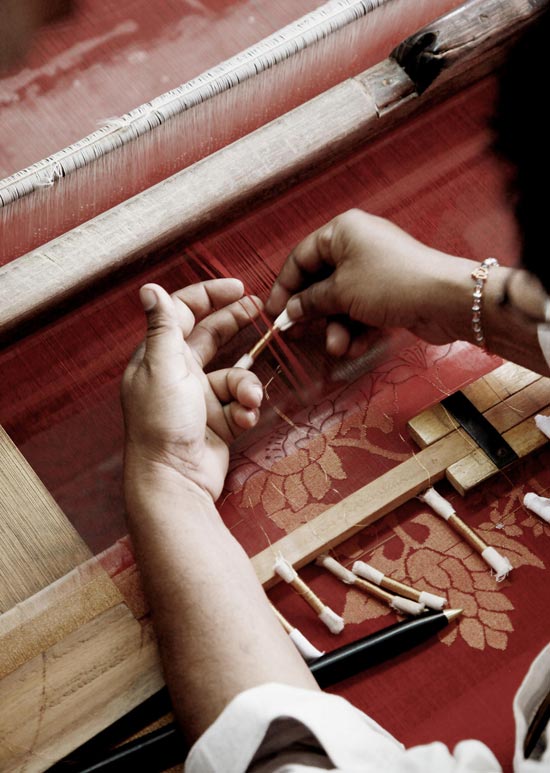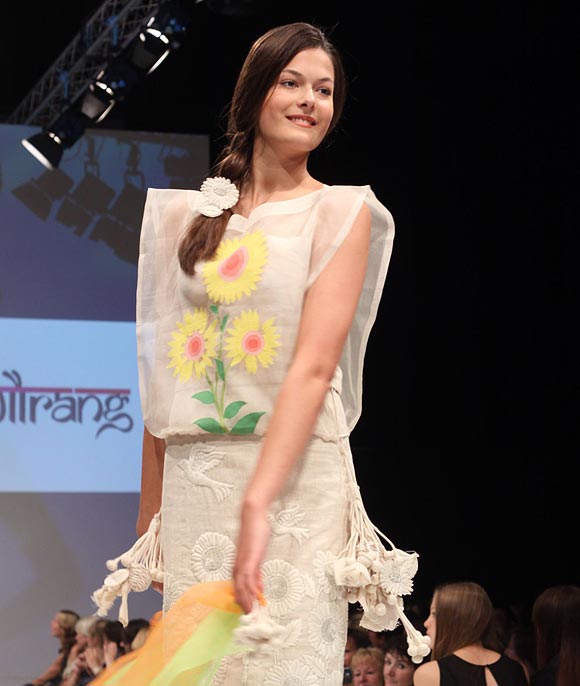
Gaurang Shah, an award winning textile designer, has created a revolution in India; he is trying to give rebirth to a dying art like weaving and popularising a dying material like khadi.
He works with 450 weavers across five states in India and they showcase their stunning designs all over the world; the recent event was the Berlin Fashion Week.
He was also awarded the Best Designer at the recently concluded Lakme Fashion Week.
In this interview with Shobha Warrier, this self taught textile designer, who calls himself an entrepreneur, talks about reviving khadi and working with rural artisans.
How did your association with weavers start?
I started working with weavers 10 years back. My father has a store for matching blouses since 1962. From the age of eight, I used to go and help him out after school. By seeing various kinds of fabric for many years, I got interested in materials.
After my college, I joined my father's business and in 1999, I opened an exclusive store for saris. I identified a weaver from Uppada in Andhra Pradesh, to source saris. I found that people were not interested in those saris as the fabric was not good and the colour combination, dull.
Nobody wanted to wear those saris. So, I spoke to the weavers and we changed the whole fabric and made the design more contemporary and colourful and very bright. Slowly, I started innovating on the material and design.

How do you describe your interactions with the weavers?
What I did first was just observe them. I tried to learn how they wove and what their limitations were. They used to weave only small, minute designs but slowly, I started giving them bolder floral and geometric designs.
You mean you never did any embroidery; only wove designs on the fabric...?
Yes, I only weave designs on the fabric. What others do through embroidery, attaching border, printing, etc, I do in weave. That is my forte.
What motivated you to weave floral designs, butterflies, peacocks, etc on fabrics?
My inspiration is nature. I want people to experience the same happiness while seeing my fabrics. I use the vibrant colours that you see in nature and you feel peaceful seeing them. If I weave a lotus flower on a fabric, I want everyone to feel that it's a real flower!
My weavers are doing it wonderfully well too.

Initially when you asked the weavers to weave such designs, how did they react?
It took some time for them to do what I wanted. They live in some remote villages and they do not know what urban women want. They just did what their forefathers had been doing for ages. So, they needed guidance to move away from the beaten path.
When they came to know that the new weaves were being liked by all and were being bought in the market, they got enthused. It meant they got more money. So, they love it now.
You started with just one weaver and now you work with 450 weavers. How was the life of the first weaver when you met him?
I started working with a weaver in Uppada in 2000. At that time, the family was living in a small hut with just one gloomy room where they used to sit with the loom and weave. There was no electricity in the house, and there were no roads in the village.
Today, if you go and see the village, you will see that there are pucca roads. The weavers have concrete houses with 2-3 rooms with all the amenities like TV, fridge, etc. in them.
Earlier, each of them had only one loom, today they have 2-3 looms and they employ youngsters who want to learn the art.

How did you get attracted to khadi?
In 1999-2000, the craze was for Chiffon, Georgette, etc. Nobody cared for khadi. I was looking for an alternative to silk and suddenly one day I found a weaver weaving khadi saris. I liked the fabric a lot and the structure of the material also was very good. It was falling better than silk and it was more long lasting and cheaper than silk.
More than that, the weavers I met were ready to weave the jamdani designs (the origins of this design are said to be in Persia and mostly consists f geometric and floral patterns) that I wanted. The fabric was so heavy that even the heavy jamdani I wanted could be done on the material.
I wanted to re-introduce such a wonderful material to Indians and the world and tell that this is part of our heritage.
Did you have difficulty in making modern India accept khadi?
Yes, I did. It took me three years to make my customers understand what I was saying. At that time, my almarahs were full of stock; the khadi saris hardly sold. I had to hard sell them to my customers, and I sold them at cost price.
I used to tell my customers that even after 10-15 years, the khadi saris would look new but they did not believe me. Today, those who bought in the beginning come and tell me the same thing.
Today, it is a totally different picture. My almarahs are always empty. I have so many orders that I find it difficult to meet the demand. It takes 7 to 8 months for the weavers to make one heavily designed sari.

You said it took you three years to make people buy khadi saris. How tough were those three years for you as an entrepreneur?
They were the toughest three years of my career. I had to pay my weavers to weave what I wanted. I did not want my weavers to go and work for somebody else. At the same time, I was forced to sell at cost price as there were not many takers for khadi.
Is the younger generation in the villages interested in weaving, or are they looking for other jobs?
Yes, that is the biggest problem I face. Most of the weavers are growing old and the new generation is not interested in weaving. They are not interested in sitting in front of a loom for months; they are looking for jobs in factories and IT companies.
Look at Kancheepuram. The weaving industry is finished there. All the youngsters prefer working in a Ford or a Nokia or a Hyundai factory to weaving. They get more money by working in the factories than in weaving.
In Mangalgiri in Andhra also, young weavers prefer working in industries and not in handloom.
Also, power looms have replaced large numbers of handlooms.
At the same time, in one village in Andhra, I started with one weaver, and today 70 weavers' families work for me; that is 90 per cent of the weavers in the village.
You work with 450 weavers across many states now. Tell us about your experience of working with them
These 450 weavers are spread across five states: Maharashtra, Rajasthan, Andhra Pradesh, Uttar Pradesh and Tamil Nadu.
One of the problems I faced in Uppada was, buyers started going directly to my weavers to buy my designs. Some of the weavers even sold my saris directly. So, I had to stop working with them and I stopped all the 125 looms I had there. When I give them designs and pay for their work, I expect them to work for me. Now, I have a secret place where I have looms and weavers work on my designs.

Can you elaborate how you work with the weavers?
After Pongal, the weavers are ready to change the designs. Last year, it took them four months to weave one sari. The intricate designs I have given this year may take them 6 to 7 months to weave, and they are ready to do that.
At present, I work with 450 weavers. I am ready to have 1000 weavers if I can get them to work for me.
You were at the Berlin Fashion Week last month. How did the international crowd react to your designs and the fabric?
Berlin Fashion Week was one of the best in the world and I had to be there to make an international presence. And, I got a standing ovation from all the 500 people and 90 per cent of them were non-Indians. It was an overwhelming experience.
I had used floral designs with flying birds, etc on khadi. Other designers took the effort to call and tell me that they felt so peaceful looking at my designs. See, it is like sitting in your garden in the morning. You feel tranquil if you sit there even for ten minutes.
They all said that they saw someone showing the tradition of India. I strongly feel that when you go to international festivals, you must show our fabric, our designs, our culture and our traditions. What is the point in doing what they are doing?
I showed saris to them saying this were what Indian women wear.

How was their response to khadi?
Extremely good. They saw it as an alternative to their regular clothing. I showed them khadi in all western wear too. The show was for eco-friendliness, and what better material than khadi can there be for eco-friendliness?
After the Berlin Fashion Week, I have got invitations from Vancouver Fashion Week, London Fashion Week, etc.
How important was getting the best designer award at the just concluded Lakme fashion week?
I was selected as the best designer on Indian textiles and hand weave. Nobody shows Kancheepuram saris or traditional weave at the fashion weeks, and that was why I wanted to show the traditional vibrant Indian designs in an Indian material. I used only four colours.
Are your saris not expensive and beyond the reach of ordinary people?
Yes, the jamdani designs that are fully woven are very time consuming to weave, so they are expensive. They may cost around Rs 80,000. But we also weave saris in the range of Rs 12,000 to Rs 13,000 with simple designs. Remember, in all my saris, designs are woven.
Where do you see the future of khadi?
It will be there for many, many more years. Like it has survived all these years, it will survive some more years. I am quite hopeful.